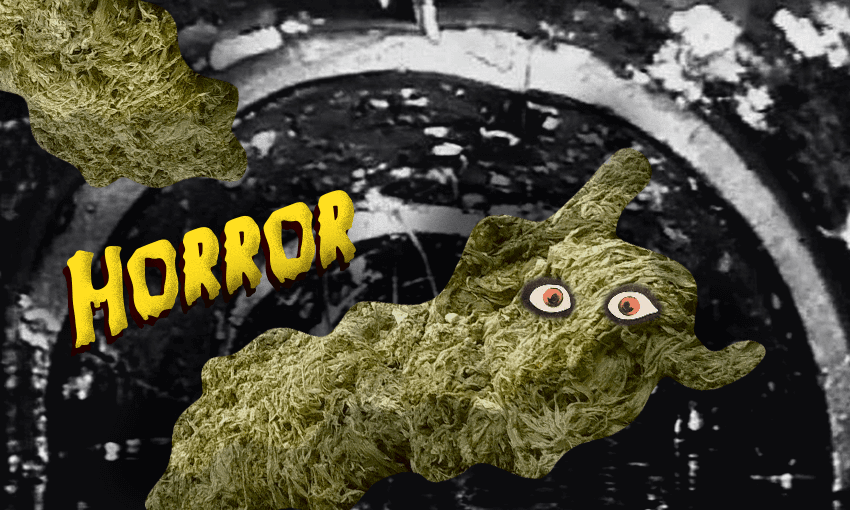Wet wipes and fat are combining in our sewage systems to form truly horrifying ‘rag monsters’. Sam Brooks talks to one of the engineers tasked with exterminating them.
Last Wednesday, as most of the workforce was going about the business of getting through another hump day, somebody at Wellington Water was crafting this tweet:
Brace yourselves … it's time for another round of 'What's in your pipes Wednesday?" 🤢
This is what we call a rag monster. It's the result of people flushing wet wipes and other non-flushable items down the loo. 🚽
Only flush the 3 P's: Poo, Pee and (toilet) Paper. 💩🟡🧻 pic.twitter.com/r4CexsQElq— Wellington Water (@WgtnWaterNZ) May 31, 2022
This is nothing like what Bobby “Boris” Pickett described in ‘Monster Mash’. If Mary Shelley and Bram Stoker were alive to see it they’d pack up their quills and find another genre. This is a rag monster, a congealment of wet wipes, fat and other waste from the sewage system. And like most monsters, it was created by the world’s greatest evil… man.
"What's in your pipes Wednesday?" ⁉️
When wet wipes are flushed down our loos they clump together and turn into nasty rag monsters. Rag monsters block the pipes and can contribute to wastewater overflows. 🤢
Only flush the 3 P's:
Poo, pee and (toilet) paper!💩🟡🧻 pic.twitter.com/XOKzRVNbJz— Wellington Water (@WgtnWaterNZ) May 10, 2022
Rag monsters are a distressingly frequent sight in our wastewater systems – Wellington Water has posted three different examples since March. They’ve started calling these posts “What’s in your pipes Wednesday?” which is a cry for help if I’ve ever heard one.
“Wet wipes don’t break down like toilet paper does,” says Wellington Water customer planning engineer Sean de Roo, the real-life Van Helsing whose job it is to vanquish these rag monsters from our sewage system. “They get caught up in the network and they all accumulate on each other.”
Rag monsters, he says, are a different beast from fatbergs. The former is predominantly made out of wet wipes, while the latter is more oil and fat-based, usually from people washing cooking grease down the sink. There doesn’t seem to be a precise formula to summon either monster, but basically anything beyond the three Ps (pee, poo and (toilet) paper) probably isn’t helping.
The time it takes to form a monster like the one found last week depends on the size of the network and the volume and frequency of stuff outside the three Ps being flushed. “If you get a street where people are flushing a lot of fat or wet wipes, and they’ve got into a habit of doing it, then it’ll form a lot sooner,” says de Roo. “It could form over weeks, months… even years.”
Exterminating these monsters is not a simple process. The team uses flusher trucks, with a high-pressure hose that goes into the network to break the monster into pieces. They then use a different hose – de Roos describes it as like a giant vacuum cleaner – to suck out the waste and all the solid built-up material (rag, fat, oil and god knows what else).
Sometimes, though, the Rag Monster is simply too large to defeat this way. Then the team has to manually remove it from the pipes, which de Roos emphasises is “not really a nice job to do”.
Welcome back to another round of "What's in your pipes Wednesday?"
Our crews recently found this lawn mower wheel blocking up one of our wastewater pipes. How does one flush a lawn mower wheel …? 🤔
Only flush the 3 P's: Poo, Pee and (toilet) Paper! pic.twitter.com/VNmsJwAEl9— Wellington Water (@WgtnWaterNZ) May 18, 2022
Water New Zealand estimates that it costs about $16m per year to unblock pipes and other damage caused by wipes and other unflushable items. In an effort to curb this cost, they recently announced the publication of new Australian-New Zealand flushability standards. Flushable products will carry the logo of a person flushing an item – if it’s got the logo, you’re all good to flush.
“Everybody has to do their bit, look out for the environment,” says de Roos. “Put the right thing down the toilet, right thing down to the sink, and we’ll have clean things happening.”



